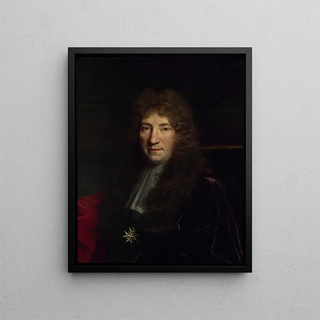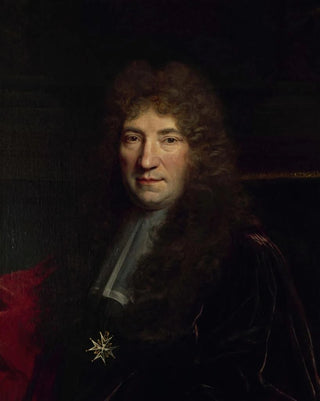Art print | Portrait of a Parisian alderman - Nicolas de Largillière


View from behind

Frame (optional)
Portrait of a Parisian alderman - Nicolas de Largillière – Captivating introduction
In the vast panorama of art history, certain works stand out for their ability to capture the very essence of their era. "Portrait of a Parisian alderman" by Nicolas de Largillière fits into this tradition, offering a window into 18th-century French society. This painting, both monumental and intimate, not only showcases the undeniable talent of its creator but also highlights the subtleties of a pivotal moment in history. By contemplating this piece, the viewer is transported into a universe where refinement and power intertwine, revealing the social and cultural dynamics of the time.
Style and uniqueness of the work
Largillière's style is characterized by impressive technical mastery, a keen sense of color, and particular attention to detail. In "Portrait of a Parisian alderman," the artist manages to transcend the simple portrait to provide a true representation of the subject's personality. Every brushstroke seems loaded with meaning, every drape of clothing demonstrates unparalleled craftsmanship. The lighting, skillfully orchestrated, plays a crucial role, illuminating the alderman's face while gently darkening the background. This contrast highlights the character's features, emphasizing his authority and presence. Largillière does not merely paint a man; he immortalizes an emblematic figure of Parisian life, a man of power whose expression and posture testify to unwavering confidence.
The artist and his influence
Nicolas de Largillière, born in 1656 in Paris, is one of the most influential portraitists of his time. His artistic journey is marked by training with Flemish masters and immersion in European artistic currents. Largillière successfully combined the techniques of his predecessors with a French sensibility, creating a unique style that profoundly impacted portrait art. His works, including "Portrait of a Parisian alderman," helped define the standards of portraiture in the 18th century, influencing many artists who followed. His ability to capture the psychology of his subjects, to reveal

Matte finish

View from behind

Frame (optional)
Portrait of a Parisian alderman - Nicolas de Largillière – Captivating introduction
In the vast panorama of art history, certain works stand out for their ability to capture the very essence of their era. "Portrait of a Parisian alderman" by Nicolas de Largillière fits into this tradition, offering a window into 18th-century French society. This painting, both monumental and intimate, not only showcases the undeniable talent of its creator but also highlights the subtleties of a pivotal moment in history. By contemplating this piece, the viewer is transported into a universe where refinement and power intertwine, revealing the social and cultural dynamics of the time.
Style and uniqueness of the work
Largillière's style is characterized by impressive technical mastery, a keen sense of color, and particular attention to detail. In "Portrait of a Parisian alderman," the artist manages to transcend the simple portrait to provide a true representation of the subject's personality. Every brushstroke seems loaded with meaning, every drape of clothing demonstrates unparalleled craftsmanship. The lighting, skillfully orchestrated, plays a crucial role, illuminating the alderman's face while gently darkening the background. This contrast highlights the character's features, emphasizing his authority and presence. Largillière does not merely paint a man; he immortalizes an emblematic figure of Parisian life, a man of power whose expression and posture testify to unwavering confidence.
The artist and his influence
Nicolas de Largillière, born in 1656 in Paris, is one of the most influential portraitists of his time. His artistic journey is marked by training with Flemish masters and immersion in European artistic currents. Largillière successfully combined the techniques of his predecessors with a French sensibility, creating a unique style that profoundly impacted portrait art. His works, including "Portrait of a Parisian alderman," helped define the standards of portraiture in the 18th century, influencing many artists who followed. His ability to capture the psychology of his subjects, to reveal






